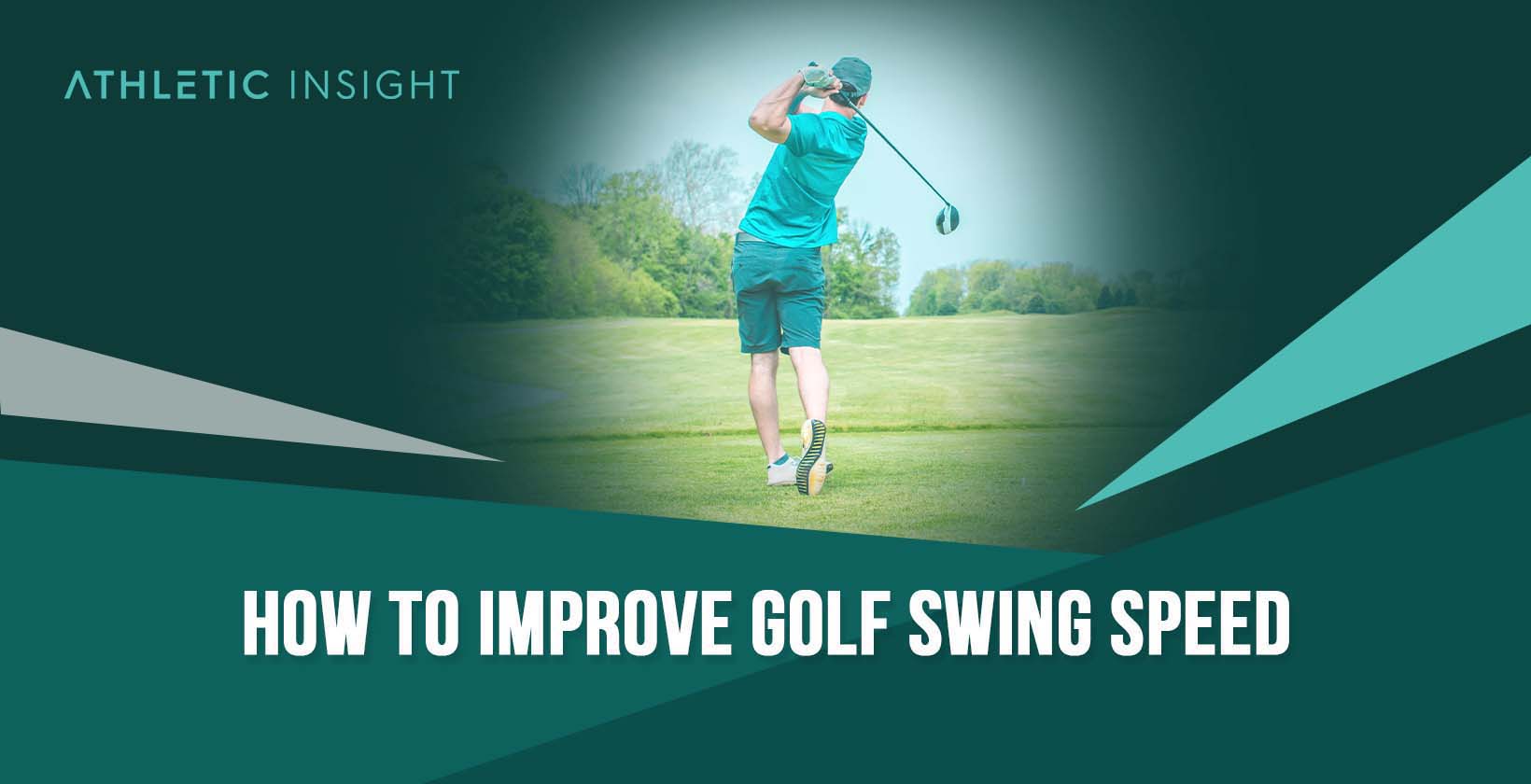When working to improve your golf performance, one of the first steps to take involves enhancing your golf swing speed. A golf swing is how you move your golf club to hit the ball. There are many golf swing manuals out there providing tips and tricks on getting the perfect golf form. There are three aspects to golf swing theory; Pre-Swing, Golf Swing and Post-Swing.
The golf swing technique you choose impacts the distance, speed, spin, and position of your ball. If you work on improving golf swings, you can increase your golf performance, reduce the chance of injury, and develop golf-ready physiology.
While golf looks fairly simple, it is a surprisingly demanding sport. Why is golf so hard? It puts a lot of pressure on your spine and wrists from the frequent twisting and swinging of the club. You will need to do some cross-training to balance your musculature with workouts to improve your golf game and prevent injury.
So, how long does it take to be good at golf? While this answer depends on your skill level, physical form, and time to practice, it usually takes approximately two years to become skilled.
One technique to improve your golf performance is through individualized imagery intervention. Imagery intervention involves performing a mental practice of your golf swing and visualizing your performance on the field.
Also, imagery interventions can optimize your flow states. Flow states are a psychological state that happens when someone senses a balance between their capabilities and challenges associated with the situation. Here are some tips to get a better golf drive.
1. Visualize Your Golf Swing Shape
Visualizing your golf swing shape is a crucial aspect of golf swing improvement. You can imagine your golf swing almost anywhere:
At home, you can imagine hitting the ball. Visualize a relaxed position over the ball, and see yourself performing a comfortable, smooth swing. Then, imagine the follow-through of the strike.

When you are about to hit the ball at the range, visualize the ball’s flight and landing area.
On the golf course, you can use imagery to picture the landing area, shape, and type of shot. Work on creating a clear image of your form. Imagine yourself standing comfortably over the ball, and keep your thoughts positive as you carry through the shot.
2. Adjust the Golf Ball Height Before Swinging
The ideal golf ball height depends on the type of shot you take.
If you are performing a stock iron shot with a straight launch direction, normal trajectory, and no curvature, you will want to place the ball slightly behind the swing arc’s bottom. It should be under your left ear or the logo of your shirt.
For the perfect golf swing with a driver, you do not want to swing steeply. Instead, you want to contact the ball while the clubhead moves more level. So, you move the ball to the swing arc’s bottom, not behind. Try to place the ball by your left heel or the instep of your front foot. This position will maximize distance.
To make an accurate, low, and consistent driver swing, you could position the ball under your left ear once more.
By combining these techniques with good golf swing form, you can drastically improve your golf swing speed.
3. Get Wide Early
Start by straightening your left arm in the backswing. Do not lock your elbow. Also, try to prolong your wrist hinge during the backswing to widen the swing. Avoid hinging your wrist until it is at least as high as your waist.

Move your head laterally to widen your swing. Transfer most, but not all, of your weight to the inside of your right foot, and keep your shoulders level as they rotate by dropping your left shoulder down as you draw the club backward.
Maintain the distance between your elbows through the forward swing to keep the width.
4. Rotate the Golf Club at the Top
You want your golf club face to be planar to the ball at the top of the swing. However, human anatomy does not let you keep the club square throughout the swing. Instead, you must rotate the club at the top of your backswing.
You do not need to actively rotate your wrists during the downswing to keep the club-face square. Instead, you should let them hinge freely. Reducing your grip pressure can increase the flexibility of your wrists. If you were to rank pressure from a scale of 1-10, with 10 being the hardest, try to squeeze the handle in the 3-5 range.
During your backswing, try to reduce the clockwise rotation of your left wrist. This step will help you match your opening and closing club-face rotation. You can achieve this by actively rotating your left wrist counterclockwise near the top of your backswing. That will rotate the club at the top and help you keep your club-face in planar contact with the ball.
5. Use Your Hips to Give Weight on the Swing
When performing your backswing, you can keep your hips loose as you turn them backward. On the transition to the downswing, you lead with your left hip to make your pelvis square to the ball.

You want your hips to face the ball as your left arm becomes parallel to the ground. Keep your stance wide as well to help you slide and rotate your hips to the front.
What Is the Performance Golf Zone Model for Golf Performance?
Performance Golf Zone (frequently called PGZ golf) is an online platform that offers video tutorials to improve your golf swing. Many of the lessons are free, but you will need to pay for a subscription to access many courses, such as the Distance Code. This course claims to help you increase your drive by 20-30 yards.
If you are struggling with good golf form, you can join the Scratch Club and watch some Scratch Golf Academy videos to gain distance, improve accuracy, and lower your handicap.
What Are the Effects of Individualized Imagery Interventions on the Flow States and Golf Performance?
Individualized imagery intervention is a sports technique that can help you improve your golf swing form. It involves practicing your shots through visualization techniques, also known as mental imagery. Some studies show that this practice is nonproductive, but others suggest that you can improve your flow states.
As previously mentioned, flow states are psychological states where you balance your capabilities and challenges associated with the situation. By visualizing your golf swing on and off the course, you can potentially improve your flow state intensity, flow state frequency, and overall performance.
While not directly related to golf, these interventions can also improve your mental imagery abilities in other areas.
What Exercises Can Increase Golf Swing Speed?
To increase your golf swing speed, focusing on exercises that build core strength, flexibility, and explosive power is key. Rotational exercises, such as Russian twists and medicine ball throws, directly enhance the core muscles involved in the golf swing, leading to increased torque and speed.
Plyometric exercises, including box jumps and squat jumps, develop explosive leg strength, crucial for initiating the downswing with power.
Resistance training, particularly exercises like deadlifts and bench presses, increases overall muscle strength, which contributes to a more forceful swing. Incorporating flexibility routines, such as dynamic stretching and yoga, can improve range of motion, allowing for a longer swing path and potentially higher swing speed.
For dedicated golfers aiming to improve their game, integrating these exercises into a regular training regimen could result in noticeable enhancements in swing speed.
Which Dietary Choices Fuel a Powerful Golf Swing?
The dietary choices that can fuel a powerful golf swing prioritize balanced nutrition to support muscle strength, energy levels, and concentration throughout a round of golf.
- Proteins: Lean proteins, such as chicken, fish, and legumes, support muscle repair and growth, essential for maintaining the strength required for a powerful swing.
- Complex Carbs: A complex carbohydrate, found in whole grains, fruits, and vegetables, provides sustained energy release, ensuring that golfers maintain high energy levels and focus.
- Healthy fats, such as those from avocados, nuts, and olive oil, are crucial for joint health and can help manage inflammation, keeping the body flexible and ready to swing.
- Hydration: Hydration, often overlooked, is critical; even mild dehydration can impair physical performance and cognitive function.
Golfers looking to optimize their swing power should consider a diet that supports overall athletic performance, focusing on hydration, and balanced intake of macronutrients.
Are There Supplements to Enhance Muscle Strength for Golfers?
Yes, supplements can help enhance muscle strength for golfers, contributing to a more powerful golf swing.
- Creatine: Creatine is one of the most researched supplements known for its ability to increase muscle strength and power output, which can translate to improved swing speed and endurance.
- Protein Supplements: Protein supplements, such as whey or plant-based proteins, support muscle recovery and growth, particularly useful after strength training sessions.
- Omega 3’s: Omega-3 fatty acids, found in fish oil supplements, can aid in reducing inflammation and improving joint health, allowing for smoother and more powerful swings.
- Calcium and Vitamin D Supplements: Calcium and vitamin D supplements are important for bone health, which is foundational for all athletic movements, including golf.
While these supplements can support the physical demands of golfing, they should complement a well-rounded diet and training program. As with any supplement regimen, it’s advisable to consult with a healthcare professional to ensure compatibility with individual health needs and adherence to any regulations or guidelines specific to the sport.


